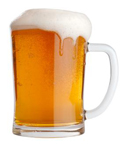Carrie Miller explains that there’s really only one legitimate reason for drinking…
You may have been too pissed to notice, but there’s been a substantial increase in public health warnings about the dangers of too much alcohol. With these have come various awareness campaigns and a number of events that the average punter can get involved in to reduce their drinking. So far this year we’ve had Feb Fast, Dry July, and we’re in the middle of Ocsober – all initiatives that encourage people to get off the grog for a month.
Ocsober is a fundraising initiative with the money raised going to Life Education which teaches Australian children “how to enjoy a healthy lifestyle by resisting participation in drug and alcohol abuse”. Its website claims that Ocsober “is also an important opportunity to highlight the growing danger of binge drinking and alcohol abuse, particularly among young Australians. Participants can also enjoy other potential benefits from a month off alcohol including feeling healthier and fitter, weight loss and the chance to enjoy Sunday mornings again!”
How could anyone argue with that? Sounds peachy to me. But it got me thinking – what would the art world be like if it was booze-free?
Since the Ancient Greek philosopher Aristophanes proclaimed: “Quickly, bring me a beaker of wine, so that I may whet my mind and say something clever” the Western world has linked creativity to intoxication in various ways.
This is particularly true of writers, musicians and, of course, visual artists. Many of the greatest of these are celebrated drunks and drug addicts. So what is at base in this connection between substance use and abuse and creative output?
One view is that the ‘doors of perception’ get unlocked when consciousness is altered and that the quickest route to unlocking these doors is getting rotten. The psychologist and philosopher William James summed up this view when he claimed that “the sway of alcohol over mankind is unquestionably due to its power to stimulate the mystical faculties of human nature”.
I know a prominent Australian artist who gave a talk at an art school to final year students who, when asked what was the best way to get past your inhibitions to make the first mark, he replied “Large amounts of drugs and alcohol”.
And this is a view that has become one of the dominant narratives in public discourse about the nature of the artist as tortured soul. The mainstream media has a pre-written script ready to plug into each instance where an artist crashes and burns by the bottle or the needle.
I’ve been to a dinner party as the guest of a well-known artist where he was feted by the rich art collectors who held on to his every, slurred word. After shooting up in the well-appointed bathroom he promptly nodded off face first into the squid ink pasta and everyone thought they were witnessing greatness. I’ve been thrown out of one of Sydney’s rougher pubs for less.
There is also the case of one of Australia’s greatest living artists – a notorious drunk – being cleaned up to attend an opening at one of Australia’s most prominent commercial galleries. He sat, or rather leaned, on a chair, incoherent until he shat his pants and people still treated him like royalty. Ordinary people would get a punch in the face for that sort of behaviour.
I think this points to the fact that, to some extent, being a drunk or an addict if you’re an artist is more of an opportunistic thing. People buy into the myth and artists, conveniently, let themselves buy into it. Let’s face it, accountants can’t show up at work at 9am in paint splattered clothes and plonk a bottle of vodka on their desks and then tell their bosses that they need it to produce” great work”. They can’t complain about an “existential crisis” that might prevent them from producing the monthly report.
And a clear example of the way the romantic view of creativity and drug and alcohol abuse falls down is that not all creative professions have a history of such abuse. Being a smashed ballet dancer or a half-cut conductor wouldn’t get you very far.
The best example however is that one of the single most banal and mediocre artists of our time was the poster boy for the tortured, drug addicted, creative soul. Exhibit A: Brett Whiteley. The defence rests, Your Honour.
The only excuse I reckon is a worthy defence for being ratfucked if you’re a creative producer in a business like art where you have to deal with an astounding array of non-thinking people is the one Ernest Hemingway once gave: “An intelligent man is sometimes forced to be drunk to spend time with his fools.”

